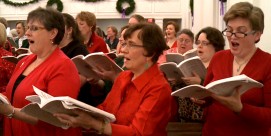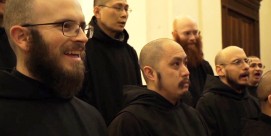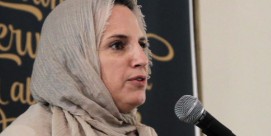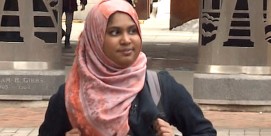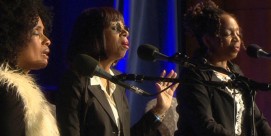In This Episode << SLIDE LEFT TO SEE ADDITIONAL SEGMENTS
Sister Corita
Sister Corita (1918-1986) was a member of the Order of the Immaculate Heart of Mary in Los Angeles and an influential graphic artist. She used bold typography, vivid colors, advertisements, lettering, logos, slogans, texts, mass media, and quotations from sources ranging from the Bible to the Beatles to create social and spiritual messages that commented on the cultural and religious issues of her era. Today, a new generation is rediscovering her work, attracted by what has been called “her festive involvement with the world” and her interest in “blurring the line between art and life.” The current exhibition of a selection of her prints at the National Museum of Women in the Arts in Washington, DC is drawn from the collection of Rev. Robert Giguere (1918-2003), a member of the Society of St. Sulpice. Watch an audio slideshow and listen to an interview with Kathryn Wat, curator of the exhibition “R(ad)ical Love: Sister Mary Corita.” Photographs by Patti Jette Hanley. Edited by Fred Yi.
KATHRYN WAT(Curator, National Museum of Women in the Arts): Corita’s art from the 1960s, which is based in advertising, has this great pop appeal to us today in our media-saturated culture. All of this art spins off of her intense emotional response to the issues of her time. In the ’60s, of course, here in America you’re dealing with the Vietnam War. This is certainly on everyone’s mind, and in addition the civil rights movement, which was very close to her heart. She’s in the middle of this maelstrom and seeks to make sense of it from her perspective as a nun.
I think that the tenor of the 1960s involved a push-pull with religion. There’s a work in the exhibition called “People Like Us Yes.” It includes text by Father Maurice Ouellet, who was active in the Selma marches in 1965, very high profile. And so, yes, you did have men and women religious who were involved with the politics of the time, but you also have this pop culture that is exploding with music and drugs and activities that seem sort of antithetical to, as I say, mainstream religion. So I see Corita involved in this push-pull that was happening across the spectrum in the 1960s.
There are works in this exhibition that feature texts from the Bible. There are several works that incorporate Proverbs. She quotes from many Christian authors, and so the Christian content is in the exhibition. But the way that she turns it and twists it by juxtaposing it with secular content and certainly with secular imagery that she’s drawing from popular culture is truly unique.
A work called “Wide Open,” and Corita incorporated, she sort of blends two texts. One, this psalm, Psalm 24 verse 9, with a speech that Lyndon Johnson gave to Congress about the issues of poverty in America. And so she took those two texts and combined them here in an amazing print.
Corita was looking for words that would be very evocative and that would lead us to a different place. So she would extrapolate those words, those phrases, in some cases, the images, and contextualize them in a way that made them spiritual and engaging.
Corita’s print about John F. Kennedy and Pope John XXIII incorporates the logo of the Sunkist citrus-growing company which was actually based in Los Angeles, and she also printed in some lemons and what looked to be limes, incorporated those elements into the print. She often used the word “sun” or an image of the sun to signify a person or an idea that she found particularly enlightening or clear-eyed, someone who was a visionary.
She certainly understood the outside art world and that it was distinct from her and different from her. She was interested in it, she engaged with it, but she stayed her own course. She had a certain task that she wished to accomplish through her art, and whether it was fashionable or favored by the art market, she wasn’t so interested in. I would say she had to have been the least naive nun that I can think of for sure.
I think that we feel that we’re living in dark times, and we look at this work, and we see someone who is creating supercool art that is very hip, but that is filled with a sincere spirit, and I think that’s tremendously appealing to all of us, not just art-goers and art-lovers, but all of us.

